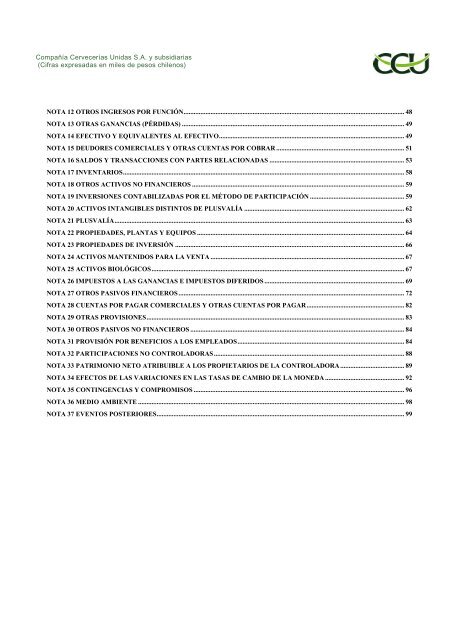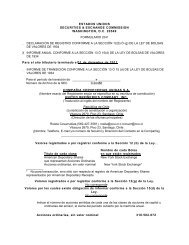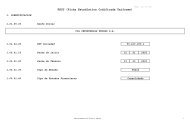INFORME SVS SEPTIEMBRE 2011 CCU S.A.
INFORME SVS SEPTIEMBRE 2011 CCU S.A.
INFORME SVS SEPTIEMBRE 2011 CCU S.A.
Create successful ePaper yourself
Turn your PDF publications into a flip-book with our unique Google optimized e-Paper software.
Patient no.SexSDHD mutationtype/familyTable 1. Patient characteristics.Age at initialdiagnosis, yGlomus caroticumtumor(s)Extra-carotid paraganglioma locations1 M Y114C / A 43 Bilateral* Glomus jugulare, intracranial2 M Y114C / A 69 Bilateral* ?3 F Y114C / A 26 Bilateral* Paraspinal4 F Y114C / A 45 Bilateral* Glomus vagale and jugulare5 F Y114C / A 26 Right* Paraspinal, paratracheal6 F Y114C / A 33 Left –7 F Y114C / A 40 – Glomus vagale8 F Y114C / A 48 Bilateral –9 F R38X / B 18 Bilateral* Kidney, adrenal gland,retroperitoneum, paraspinal10 M R38X / B 22 Left –11 F Exon 3 / C 37 Bilateral Paraaortal12 F Exon 3 / C 43 Left Mediastinal / pulmonary13 M Exon 3 / C 39 Bilateral –Asterisk (*) indicates extension to the cranial base; ‘‘?’’ indicates unknown; ‘‘–’’ indicates none.patients’ father, who remains tumor-free (Figure1, pedigree B).Family C (n ¼ 3) was discovered after the indexpatient (patient no. 11) and her sister (patient no.12) came to our clinic in March of 2004 for furthertreatment of known glomus caroticum tumors inboth patients. The index patient was a womanwho previously underwent surgical extirpation ofa left-sided glomus tumor in 1993 at the age of 37and removal of a mediastinal PGL in the aortopulmonarywindow in January of 2004. At the time ofarrival to our institution, she had an asymptomatic2- 3 2.3-cm glomus caroticum tumor on theright side. After establishment of a familial pattern,a glomus caroticum tumor was also discoveredin the third direct sibling (patient no. 13). Inaddition, 2 other half-siblings were reported tohave glomus tumor from the same father. The pedigreeis outlined in Figure 1, pedigree C.Screening and Surveillance. Carotid duplexultrasound was used in all cases as a screeningtool to direct further imaging. A modified screeningalgorithm was developed based on the protocolfrom Bikhazi et al 3 and is outlined in Figure 2.Genetic analysis was performed by the MolecularGenetics Laboratory of St. Anna Children’sHospital in Vienna, Austria, and by the Departmentof Human Genetics, University of Pittsburgh,in conjunction with genetic counseling providedby the Department of Human Genetics ofthe Medical University Innsbruck. Blood samplesand shock-frozen biopsy specimens were obtainedfrom Innsbruck and sent to Vienna and Pittsburghfor analysis.Glomus tumors, like many neuroendocrinetumors, express specific type-2 receptors forsomatostatin, thus enabling the use of radioactivetracers for in vivo functional imaging. 19,20Nuclear imaging was carried out using a 111Inlabeledtetra-azacyclododecane tetra-acetic acidoctreotide(DOTA-octreotide) preparation, themethods for which will be described in detail in afuture report. Whole-body planar imaging using adouble-head camera system as well as a singlephoton emission CT (SPECT) was then carriedout. Nuclear images were also obtained as aninitial baseline study for all paternally inheritedmutation-positive SDHD patients.Patients were initially followed up at 3, 6, and12 months postoperatively. Both SPECT andduplex sonography were employed for postsurgicalfollow-up. If recurrence, signs of new lesions, ormass effect were suggested, CT was obtained andfused with SPECT images with the use of an individualmattress mold for fixation. After the firstpostoperative year, patients were then followed ona yearly basis with carotid ultrasound. If multicentricfoci were initially detected, follow-up nuclearimaging every 2 years was additionally employed.For tumor-negative patients who tested positivefor a SDHD gene mutation inherited paternally,yearly clinical examination and surveillancescreening with Doppler duplex carotidultrasound was started with the patient’s 18thbirthday, since previous studies support an exceedinglyrare incidence of such tumors in pediatricpatients. 21Therapeutic Approach. Once PGL was establishedby means of a combined diagnostic866 Screening and Evaluation of Familial Paragangliomas HEAD & NECK—DOI 10.1002/hed September 2007
















